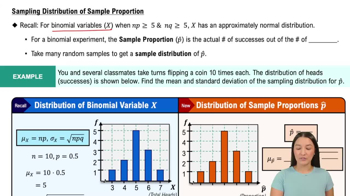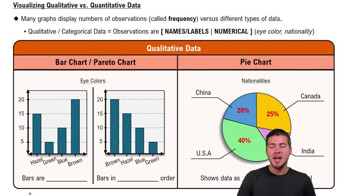Why is a sample used more often than a population?
Table of contents
- 1. Intro to Stats and Collecting Data1h 14m
- 2. Describing Data with Tables and Graphs1h 55m
- 3. Describing Data Numerically2h 5m
- 4. Probability2h 16m
- 5. Binomial Distribution & Discrete Random Variables3h 6m
- 6. Normal Distribution and Continuous Random Variables2h 11m
- 7. Sampling Distributions & Confidence Intervals: Mean3h 23m
- Sampling Distribution of the Sample Mean and Central Limit Theorem19m
- Distribution of Sample Mean - Excel23m
- Introduction to Confidence Intervals15m
- Confidence Intervals for Population Mean1h 18m
- Determining the Minimum Sample Size Required12m
- Finding Probabilities and T Critical Values - Excel28m
- Confidence Intervals for Population Means - Excel25m
- 8. Sampling Distributions & Confidence Intervals: Proportion1h 12m
- 9. Hypothesis Testing for One Sample3h 29m
- 10. Hypothesis Testing for Two Samples4h 50m
- Two Proportions1h 13m
- Two Proportions Hypothesis Test - Excel28m
- Two Means - Unknown, Unequal Variance1h 3m
- Two Means - Unknown Variances Hypothesis Test - Excel12m
- Two Means - Unknown, Equal Variance15m
- Two Means - Unknown, Equal Variances Hypothesis Test - Excel9m
- Two Means - Known Variance12m
- Two Means - Sigma Known Hypothesis Test - Excel21m
- Two Means - Matched Pairs (Dependent Samples)42m
- Matched Pairs Hypothesis Test - Excel12m
- 11. Correlation1h 6m
- 12. Regression1h 50m
- 13. Chi-Square Tests & Goodness of Fit1h 57m
- 14. ANOVA1h 57m
1. Intro to Stats and Collecting Data
Intro to Stats
Problem 1.1.17
Textbook Question
Determine whether the data set is a population or a sample. Explain your reasoning.
The number of guests in each room of a hotel
 Verified step by step guidance
Verified step by step guidance1
Understand the definitions: A population includes all members of a defined group, while a sample is a subset of the population selected for analysis.
Identify the context of the problem: The data set provided is 'the number of guests in each room of a hotel.'
Determine whether the data set includes all rooms in the hotel or just a subset. If it includes all rooms, it represents a population. If it includes only a portion of the rooms, it represents a sample.
Explain the reasoning: If the data set includes every room in the hotel, it is a population because it accounts for the entire group being studied. If it includes only some rooms, it is a sample because it represents a smaller group taken from the population.
Conclude based on the information provided: Since the problem does not specify whether all rooms or only some rooms are included, clarify that the classification depends on whether the data set is complete (population) or partial (sample).
 Verified video answer for a similar problem:
Verified video answer for a similar problem:This video solution was recommended by our tutors as helpful for the problem above
Video duration:
2mPlay a video:
Was this helpful?
Key Concepts
Here are the essential concepts you must grasp in order to answer the question correctly.
Population
A population refers to the entire group of individuals or items that share a common characteristic. In statistics, it encompasses all possible observations that could be made. For example, if we consider all the guests in every room of a hotel across all locations, that would represent the population of hotel guests.
Recommended video:

Population Standard Deviation Known
Sample
A sample is a subset of a population, selected to represent the larger group. It is used in statistical analysis to draw conclusions about the population without needing to collect data from every member. For instance, if we only look at the number of guests in a specific hotel or a few selected rooms, we are working with a sample of the overall population of hotel guests.
Recommended video:

Sampling Distribution of Sample Proportion
Data Set Context
Understanding the context of a data set is crucial for determining whether it represents a population or a sample. In this case, the data set consists of the number of guests in each room of a hotel, which implies that it is a complete count of guests in that specific hotel, thus representing a population rather than a sample.
Recommended video:
Guided course

Visualizing Qualitative vs. Quantitative Data

 2:13m
2:13mWatch next
Master Introduction to Statistics Channel with a bite sized video explanation from Patrick
Start learningRelated Videos
Related Practice
Textbook Question
1
views
